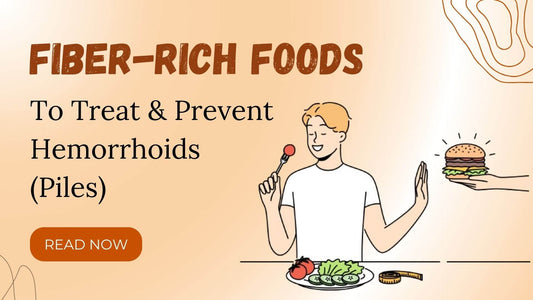
Top 11 Fiber-Rich Foods for Effective Hemorrhoid (Piles) Relief and Prevention
Piles or hemorrhoids is a medical condition that swells the veins in the anal region, causing too much pain, bleeding, and itching.
Luckily, some specific high fiber foods for piles can help alleviate these chronic symptoms and even stop piles from occurring in the first place.
In this blog, we will discuss the 11 fiber-rich foods for piles to combat piles issues.
The table below represents the foods that contain fiber (in grams) to understand one’s specific need according to their health goal:
| Foods | Fiber (in grams) |
|---|---|
| Legumes | 7-9 g |
| Apple | 3.8-4 g |
| Whole grains | 9-10.7 g |
| Artichokes | 7 g |
| Root Vegetables | 1.6-7.3 g |
| Pear | 6 g |
| Squash | 7 g |
| Bananas | 2-3 g |
| Tomatoes | 1.5-2.2 g |
| Cruciferous Vegetables | 1-4.1 g |
| Avocado | 10-11 g |
Here are 11 High Fiber Foods for Piles

Listed below we have mentioned some worthy high fiber foods for piles:
1. Legumes

As an integral part and edible seed of plants in the Fabaceae family, legumes are a great choice for the best diet for piles.
We need both soluble and insoluble fibers (piles treatment food)to promote a healthy gut system, and legumes can give you both. Legumes include:
| Foods | Fiber (in grams) |
|---|---|
| Beans | 5.2 - 9.5 g |
| Lentils | 15.6 g |
| Peas | 4.4 - 11.5 g |
| Soybeans | 9.19 - 16.5 g |
| Peanuts | 8.5 g |
| Chickpeas | 12 - 15 g |
Even though both soluble and insoluble fibers are present in legumes, they are especially rich in soluble fibers. For instance, 1 cup (198 grams) of well-cooked lentils pairs with approximately 16 grams of fiber.
2. Apple

Apples are also a piles treatment food, it has massive amounts of fiber when they have their skin on. For example, an apple contains approximately 4.5 grams of fiber, making it a good food for piles.
Moreover, apples are a rich source of insoluble fiber, and they also have pectin, a major soluble fiber that promotes gut health.
For piles, apples can soothe digestion, bulk up the stool, lessen the strain, and eliminate the discomfort associated with piles.
3. Whole Grains

The nutritional record of whole grains has 9-10.7 g fibre, commendable and worthy of praise. It is because whole grains are known to keep their germ, bran, and endosperm, which are loaded with fibers.
Whole grains are mainly amazing for providing insoluble fiber, which helps in moving digestion effectively, hence the best food for piles that can deal with pain and discomfort due to piles.
Having whole grains such as barley, oats, wheat, corn, spelt, quinoa, brown rice, and whole rye increases fecal weight and colon transit time.
4. Artichokes

Did you know that artichokes are one of the main ingredients in some traditional medicine practices for treating hemorrhoids?
One of the reasons for using artichokes in traditional medicine is their high fiber content. 128 grams of artichokes contain approximately 7 grams of fiber.
Just like other fiber-rich foods for Piles, artichokes help to feed friendly bacteria in the body, keeping digestive health in check.
What’s more, artichokes are beneficial for making piles symptoms less severe and even diminishing their pain and discomfort.
5. Root Vegetables

Root vegetables are one of the high fiber foods for piles because they are a valuable source of rich fiber and nutrients. There are lots of root vegetables, viz., sweet potatoes, turnips, beets, rutabagas, carrots, and potatoes, packed with rich nutrients.
Per serving, root vegetables have almost 3 to 5 grams of fiber, which makes them the best food to cure piles. It may also reduce constipation and ease pimple severity.
You can roast, steam, sauté, or boil these veggies, but do not peel their skin if you want to take full advantage of root vegetables.
6. Pear

A pear is one of the best fiber-rich foods for piles, as only one medium pear contains approximately. 6 grams of fiber, and it is also rich in fructose, a natural laxative.
However, it shall be more beneficial if this fruit is eaten with the skin on because in its skin, lots of fiber-defining fibers are present.
What’s more, one can boost the effect of these foods by adding the best Ayurvedic medicine for piles and fissures.
7. Squash

Whether it's winter or summer, squash is available all months of the year and can provide immense benefits in terms of fiber.
From bringing color to your table to the pure benefits of fiber, squash is one of the most amazing high fiber foods for piles.
| Foods | Fiber (in grams) |
|---|---|
| Pumpkin | 2.7 g |
| Acorn Squash | 9 g |
| Yellow Squash | 2 g |
| Butternut Squash | 6.6 g |
| Zucchini | 2 g |
Among all types of squash, acorn squash has a whopping 9 grams of fiber in every cup of this vegetable (205 grams), which is the highest share of fiber.
And it is quite evident that squash can help in reducing the effects of piles, so it is one of the best food for piles.
8. Bananas

You might have heard, probably from your parents or gym trainers, that bananas are great for gut health. This statement is true because one medium (8–20 cm) banana boasts approximately 3 grams of fiber.
Moreover, bananas are fiber-rich foods for piles, also rich in pectin and resistant starch, which keep the digestive tract smooth and feed friendly bacteria in the gut system.
9. Tomatoes

Tomatoes have everything necessary for relieving constipation. It is high fiber foods for piles as well as water-rich food, it has 1.5 to 2.2 grams of fiber, which in turn helps with constipation and, consequently, piles.
Tomatoes make it easier to pass the stool because they are high in naringenin, a natural antioxidant that can have a laxative effect on constipation, therefore, piles.
10. Cruciferous Vegetables

Cruciferous vegetables are known to deliver anticancer properties as well as insoluble fiber.
Furthermore, cruciferous vegetables are also fiber-rich foods for piles, as well as a rich source of glucosinolate, a plant chemical that is broken down by gut bacteria.
Vegetables, like broccoli, Brussels sprouts, arugula, kale, radishes, turnips, and cabbage, are cruciferous and high fiber foods for piles.
These vegetables are also linked to improving immunity. This, and its insoluble fiber contents, make cruciferous vegetables a great addition to the diet.
11. Avocados

Having avocados in your daily diet can be very beneficial for managing piles. They are a healthy source of fiber as it has 10 to 11 grams fibre, potassium, vitamins (A, C, and E), healthy fats, and nutrients, hence fiber-rich foods for piles that may help reduce inflammation, improve your digestive system, and make your stool soft and smooth, which can alleviate piles symptoms.
Avocados are indeed beneficial in moderation, but overconsumption can lead to issues like diarrhea, which might aggravate piles.
Conclusion
Hemorrhoids can make anyone’s life a living hell, and controlling them should be the priority.
Use of fiber-rich foods for piles may diminish pile symptoms, as well as staying hydrated.
Such as whole grains, legumes, tomatoes, bananas, and root vegetables are packed with high fiber. Eating them ensures warding off constipation, hence piles.
For those who are managing hemorrhoids during pregnancy or want a more comprehensive solution, it may also be beneficial to explore options such as yoga for piles, foods to avoid in piles, and understanding the types of hemorrhoids.
To speed up this process, include high fiber foods for piles and fissures, Also, you must consult ayurvedic doctors for piles treatment.
Frequently Asked Questions
Q1. Which high fiber foods for piles to eat?
Ans: Whole grains, oats, flaxseeds, lentils, apples, pears, berries, carrots, spinach, broccoli, and nuts help soften stools and prevent strain
Q2. What food shrinks hemorrhoids fast?
Ans: Leafy greens, aloe vera juice, bananas, yogurt, radishes, figs, papaya, turmeric, and probiotic-rich foods reduce inflammation and promote healing
Q3. Which piles treatment food to avoid during this issue?
Ans: Spicy foods, red meat, processed foods, fried items, dairy, caffeine, alcohol, and low-fibre foods worsen constipation and irritation.
Q4. Which Liquid diet for hemorrhoids should be taken?
Ans: Warm water, herbal teas, coconut water, fresh fruit juices, buttermilk, clear broths, and aloe vera juice help hydration and digestion
Q5. What Bleeding hemorrhoids foods to avoid eat?
Ans: Processed meats, white bread, excess salt, spicy foods, fried snacks, alcohol, caffeine, and carbonated drinks worsen bleeding and discomfort

Dr. Pooja Verma
Dr. Pooja Verma is a sincere General Ayurvedic Physician who holds a BAMS degree with an interest in healing people holistically. She makes tailor-made treatment plans for a patient based on the blend of Ayurveda and modern science. She specializes in the treatment of diabetes, joint pains, arthritis, piles, and age-related mobility issues.



